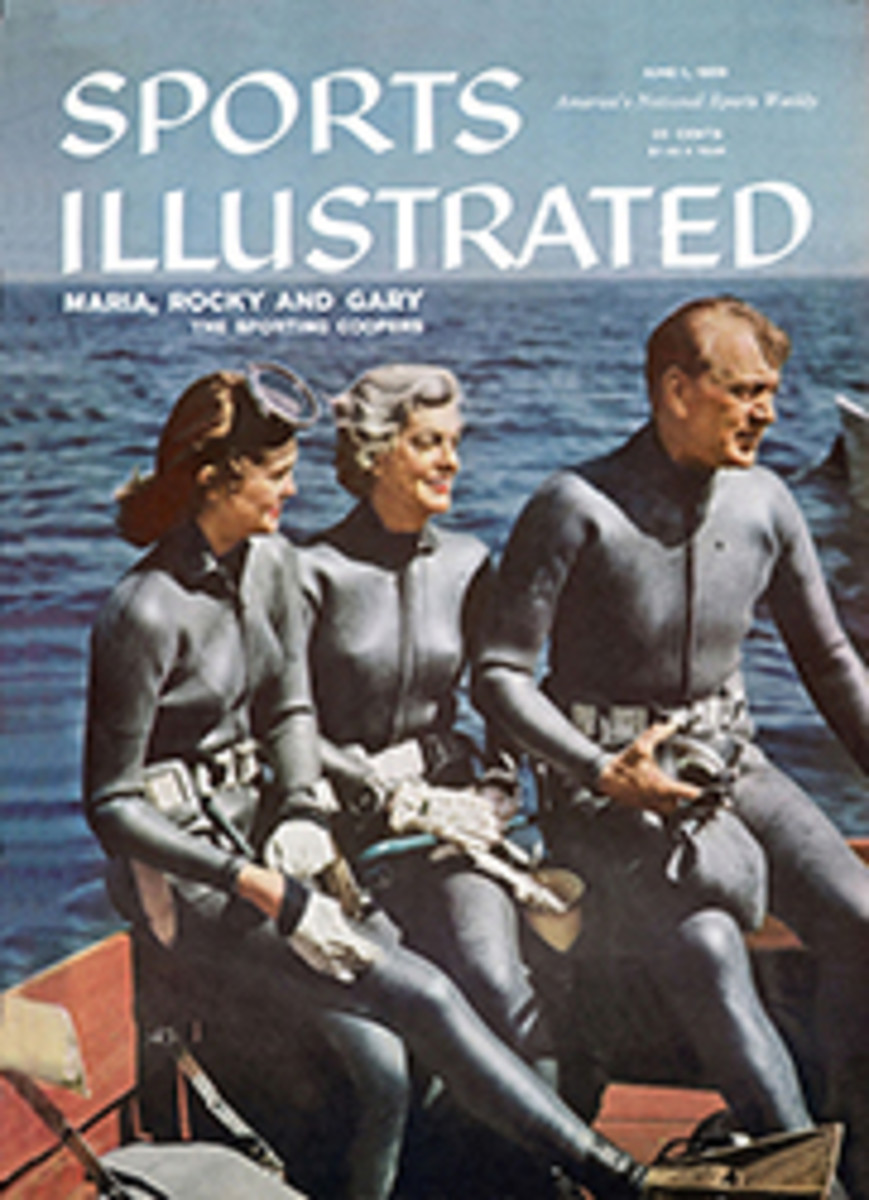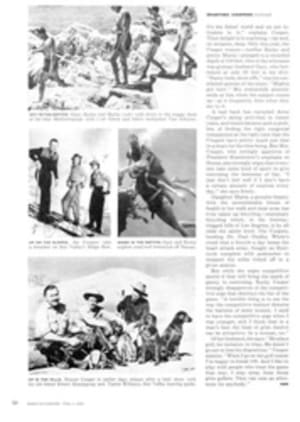
THAT INCREDIBLE 59
At the Greenbrier in White Sulphur Springs, W. Va., Sam Snead, aged 46, was playing the third round of the annual Sam Snead Festival golf tournament. The date was May 16, 1959. Sam has been the home pro at The Greenbrier's two courses since 1936, and it was superbly fitting, therefore, when on that May day a fortnight ago Sam shot the greatest competitive round of golf in the history of the game. It took him just 59 strokes to play the 18 holes. Winning his own festival the next day with a 72-hole total of 259 was an anticlimax.
Snead's magnificent 59 surpassed the official PGA record of 60 (held by Sam and six others) and completely overshadowed the only other competitive 59 on record-posted by Earl Fry in the 1938 Northern California PGA championship at Alameda, but in match play in a round-that Fry officially won at the 14th hole and played out just for the sake of a scoring record.
The day of Snead's great round was streaky with cold and gusty winds, and the fairways were soft from a drenching, all-night rain. Playing with Snead as part of the pro-amateur phase of the event were three amateurs—Bruce Forbes, president of Forbes Magazine, who, incidentally, was celebrating his 43rd birthday; Paul Summers, a Washington lawyer and native West Virginian; and Harry Daumit, the Lustre-Creme shampoo founder. Snead played the first 11 holes into a strong headwind. On the 12th tee, with the wind now at his back, he stood four under par. Then, roaring downwind, he played the last seven holes in just 21 strokes, seven under par for that final stretch. Snead's own vivid hole-by-hole description of that fabulous round starts on the opposite page.
ONE 394 yards, par 4
The first hole doglegs to the right and I hit a pretty good drive down the left side which is the best place to be. From a downhill lie I punched an eight-iron, keeping it down into the wind, and making sure I didn't go over. A good shot, nine feet past, and I made the putt.
TWO 150 yards, par 3
Just a straightaway hole into the wind with the pin in the right-hand corner of the green. I played a wind shot, punching a six-iron that had good bite and stopped eight feet to the right of the hole. Needed two putts.
THREE 420 yards, par 4
I hit a pretty near perfect drive here and then a real good four-iron into the heavy wind. The ball bounced up about five feet to the left of the hole and I knocked in the putt for a bird.
FOUR 377 yards, par 4
My drive was hit straightaway and wound up in just perfect shape on the left. Then I punched a six-iron into the wind, just like on No. 2, that had so much stuff on it it stopped, pfft, just like that, four feet to the right. Then I holed that for my three.
FIVE 372 yards, par 4
On all my drives, just like on this hole, I was really trying to get the ball out there as far as I could. Another perfect drive here and then I played an eight-iron right at the hole that I figured would stop and jerk back. But it leaked past 15 feet before biting, and I two-putted.
SIX 298 yards, par 4
I drove directly for the flag going for the green all the way, but the wind pushed it over to the left just short of the bunker. I pitched out of the rough pretty good, but the ball didn't run as much as I thought it would and I had to knock in an 18-footer for the birdie.
SEVEN 430 yards, par 4
Trying to fade my drive around the slight dogleg I pushed it into the rough. I played a five-iron out to the front of the green because the ball will often fly on you coming out of grass and I didn't want it to fly too far. It just came out normal though and I needed two putts from 30 feet short.
EIGHT 396 yards, par 4
I hit my tee shot right out across the pine trees on the corner of the dogleg and ended in perfect position. Then I hit a nine-iron right at the hole and it skipped past 12 feet to the left. Two putts for a four.
NINE 291 yards, par 4
I went right for the flag again and would have been on the green for sure except the ball hit a woman standing by the green, and it dropped off to the left. Chipped down and two-putted from 13 feet. This gave me a 31 for nine holes, but the second nine is considerably tougher and I still had plenty to do yet before thinking about a 59.
TEN 245 yards, par 3
I hit a real good three-wood to the back collar of the green. It was the only green I missed all day and I didn't really miss it, it just didn't stay on. Chipped down about a foot and a half away and made the putt.
ELEVEN 440 yards, par 4
I was trying to hit out straightaway, but I pushed the drive a little bit and it rolled into a drainage ditch where I got a free lift out. Three-iron to the green and two putts from 40 feet.
TWELVE 405 yards, par 4
This is where it started. I finished up seven under par on the last seven holes. Perfect drive and nine-iron. You can't see the green too well from the fairway, but I took a look over when I was coming down 11 to see where the flag was. Put my ball four feet above the hole, made the putt.
THIRTEEN 400 yards, par 4
Hit my drive just perfect about 145 yards from the green. The green is punch-bowl shaped and I hit a seven-iron into it that stopped about five feet past the hole. Made the putt.
FOURTEEN 179 yards, par 3
Going into the wind but slightly downhill. Hit a real good five-iron right at the flag and it ended up about 20 feet short. I just knocked the ball at the hole, and it went in for a 2.
FIFTEEN 488 yards, par 5
I expect I hit my biggest drive hereabout 330 yards. With the wind off my right shoulder I hit a five-iron at the green figuring the wind would take it up to the hole. But it hit a soft spot in the fairway and stopped on the front edge of the green. Then I stepped up and putted the ball into the hole from 30 feet away for an eagle. This was the first time I began to think I had a chance for a 59. All I needed was two birdies on the last three holes.
SIXTEEN 531 yards, par 5
Another perfect tee shot that cut across the right corner of the dogleg. Then I hit a one-iron that hopped through the narrow opening, right across the green and over the back edge. Hit a good chip coming back but it didn't stop and ran seven feet past. Then I hit the putt into the hole for my four.
SEVENTEEN 215 yards, par 3
Here you either use a four-iron and beat hell out of the ball or use a three and just let it go in. I hit a three-iron, and it was probably one of the best irons I hit during the whole damn tournament. I hit it high so it wouldn't run and it stopped five feet above the hole. I played the putt for a little break but hit it too firm and it slid out of the corner. Settled for a little old par. I said out loud, "Well, I got one more to go."
EIGHTEEN 444 yards, par 4
A tough finishing hole. The average player needs a two-wood for his second shot. They had the markers on the tee so far back that I had to tell the crowd to move back and give me swinging room. Then I just leaned back and knocked hell out of the ball. Just let it go. I had a five-iron left to the green that was going to be a 59, 60 or 61 shot. I poured it right at the hole and it hit just to the right and jumped forward maybe two-three feet. I had a two-foot putt. It was a rough little putt with a real quick break to the right. I played it to the outside of the hole, it just caught the lower corner and fell in. That was it, man, my 59.
PHOTO
HISTORIC CARD: Snead's 59 (left), combined team best (right). Checks indicate Partner Summers' 9-handicap stroke holes. Actually Summers picked up on 12 holes. Yardage played was longer than listed.
PHOTO
THE FINAL STROKE is made by Sam Snead as he rolls in a short but tricky putt. Snead, whom Tommy Armour calls the game's greatest putter, needed only 25 putts during his low round.
MAP
1
MAP
2
MAP
3
MAP
4
MAP
5
MAP
6
MAP
7
MAP
8
MAP
9
MAP
10
MAP
11
MAP
12
MAP
13
MAP
14
MAP
15
MAP
16
MAP
17
MAP
18

